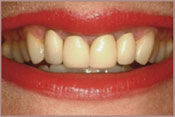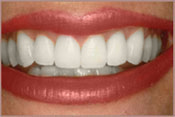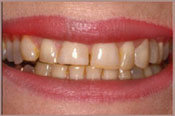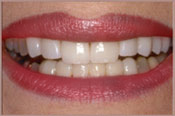Teeth Whitening
Your teeth will darken over time. As we become more mature, the outer enamel layer on our teeth becomes thinner, and the inside layer, called dentin, becomes naturally more pigmented. The combined result of those two changes results in our teeth looking overall darker. Other changes in the color of your teeth can be caused by such factors as the food and beverages consumed (like coffee, tea and soda). Other known factors for discoloration may include childhood medications or illnesses, tobacco use or imperfect oral hygiene. Restoring your naturally bright smile is a priority for our dental whitening team. We can usually brighten any person's teeth, regardless of the reason for the darkening. Tooth whitening services are growing in popularity, and it's one of the most requested services offered by our practice. Everyone sees the growing consumer market focused on whiter teeth. The reality is that "quick-fix", over-the-counter, or other "too good to be true" solutions typically don't work.
We are trained professionals using industry-approved methods. Our goal is to meet the needs of every patient, and every patient's needs are different. The method used by our practice is a gentle hydrogen-peroxide gel-activated solution in a custom made tray that you apply to your teeth every day at home. Nothing improves your appearance more than a bright, white smile!


Veneers
Veneers are thin, semi-translucent "shells" typically attached to your front teeth. Veneers are customized from porcelain material and permanently bonded to your teeth. Veneers are a great alternative to otherwise painful dental procedures to improve the appearance of your smile.
Common problems that veneers are used for:
- Spaces between the teeth
- Broken or chipped teeth
- Unsightly, stained or discolored teeth
- Permanently stained or discolored teeth
- Crooked or misshapen teeth
Veneers are a great aesthetic solution to your smile that may even help you avoid orthodontic treatment. Subtle changes to your smile can be achieved with veneers, and in most cases, veneer application is completed in only two office visits.


Dental Implants
Dental implants are artificial tooth replacements that were first developed half a century ago by a Swedish scientist named Per-Ingvar Branemark. Implants arose from the patient's need to secure loose-fitting dentures. Since the advent of the implant, engineering and enhancements to the implant have enabled dentists to expand the implant's usefulness, including the replacement of missing or lost teeth. Today, implant techniques provide a wide range of tooth replacement solutions including:
- Single Tooth Replacement
- Anterior Replacement
- Posterior Replacement
- Full Upper Replacement
If the missing tooth space has no surrounding teeth, the dentist may decide an implant is the most appropriate treatment choice or option.
Post Implant Care
Although proper oral hygiene is always recommended for maintaining good dental health, it is especially important when a patient has received a dental implant. Bacteria can attack sensitive areas in the mouth when teeth and gums are not properly cleaned, thus causing gums to swell and jaw bones to gradually recede. Recession of the jawbone will weaken implants and eventually make it necessary for the implant to be removed. Patients are advised to visit their dentists at least twice a year to ensure the health of their teeth and implants. Dental implants can last for decades when given proper care.
Composite Bonding
Bonding is a common solution for:
- Fixing or repairing chipped or cracked teeth
- Reducing unsightly gaps or spaces between teeth
- Hiding discoloration or faded areas on the tooth's surface
Often, composite bonding is used to improve the appearance of your teeth and enhance your smile. As the name indicates, composite material, either a plastic or resin, is bonded to an existing tooth. Unlike veneers or crowns, composite bonding removes little, if any, of the original tooth.
Composite bonding has many advantages:
- It is a quick process, which typically lasts less than one hour.
- It does not reduce the tooth's original structure and is relatively inexpensive.
- Composite resins come in many different shades and provide better matching of shades to the natural color of your teeth.
- Composite bonds, however, are not as durable and long-lasting as veneers and crowns and may need to be re-touched or replaced in the future.
Composite bonds stain more easily and therefore require proper care and regular cleaning. In order to ensure the longest possible duration of the bonding, composites should be brushed and flossed daily. Common staining elements include coffee, tea, tobacco, foods and candy.
Orthodontic Treatment
Today, orthodontic treatment is simple, convenient and affordable for patients of all ages. And an attractive smile is just one of the benefits. Orthodontic treatment results in correctly aligned teeth that provide ideal jaw function and a great smile! Additionally, your teeth are easier to clean and more resistant to gum disease. Perhaps most importantly, orthodontic treatment almost always provides improved self-confidence.
Each patient's orthodontic condition requires a treatment plan based on a specialized diagnosis of the case. The treatment process involves X-rays, dental impressions and photographs. Braces have one aim: to use gentle pressure to move teeth into proper alignment. Treatment time varies depending on age, patient compliance and the severity of the condition. Generally, treatment lasts for 24 months and is facilitated by ideal patient cooperation.
